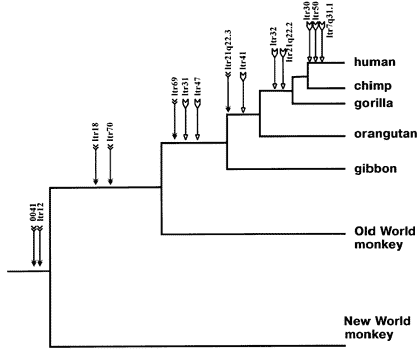Retroviruses and Evolution for dummies, by a dummy.- Viruses insert their genome into a cell's DNA (at a random place), forcing them to make copies of the virus.
- If the virus genome is damaged, or placed wrong, it might not function.
- Sometimes this can happens to sperm or egg cells (germ line cell).
- Offspring can inherit the viral insertion.
- Given that the spread of such viral insertions are rare¹, and that it can be inserted in literally billions of places in the DNA, a match in DNA sequence and placing would make a convincing evidence of decent.
- A genetic trait can, even if it is neutral, spread to a whole population (neutral drift).
- IF the TOE is accurate, we might find viral insertions that are common to multiple related species.
¹ While cells are regulary attacked by viruses the probability of a insertion gone wrong, be in a germ line cell that actually produces a offspring and being spread through a population, is
very low.

Lo and behold, we already have multiple matching lines of retroviruses found in the evolutionary tree! So, at some point in the chain of events described above, there's obviously something you disagree with. It would be really informative to know where that point is. Personally I can't really understand how not to be convinced by such evidence, but at the same time I understand that some people (at least think they) already know the TRUTH®, and will not be convinced whatever the evidence.
IF the TOE is accurate, we might find viral insertions that are common to multiple related species...we already have multiple matching lines of retroviruses found in the evolutionary tree! So, at some point in the chain of events described above, there's obviously something you disagree with. It would be really informative to know where that point is. Personally I can't really understand how not to be convinced by such evidence, but at the same time I understand that some people (at least think they) already know the TRUTH®, and will not be convinced whatever the evidence.Well, if you're trying to prove a claim of universal common ancestry then this evidence is insufficient because there are no examples of ‘shared errors’ that link mammals to other branches of the genealogic tree. It also is insufficient to establish common ancestry because it is based on the the presumption that the retroviruses are non-functional (because of the presumed randomness of the retrovirus insertion.) But just because we don't know what the function might be or have been in the past doesn't mean that there is no function. Also there is some evidence to support the idea that some of these may serve functions, and that their insertion is not entirely random.
Cordially,
